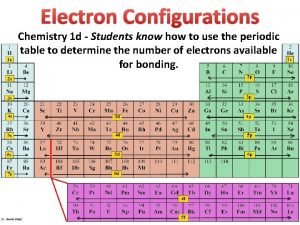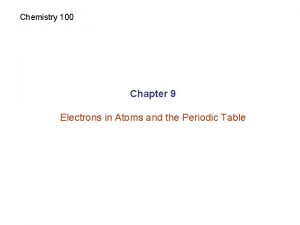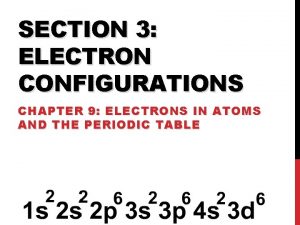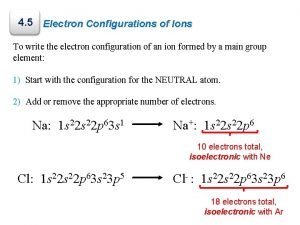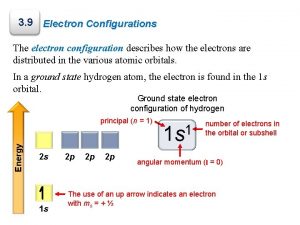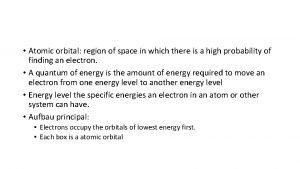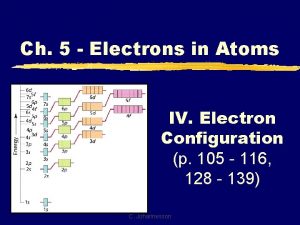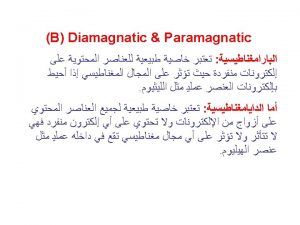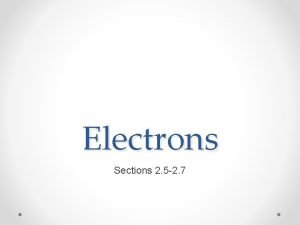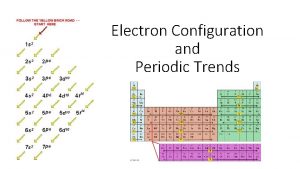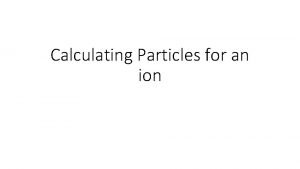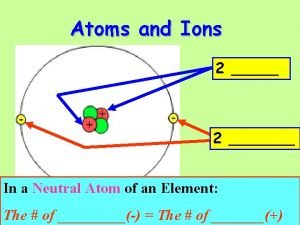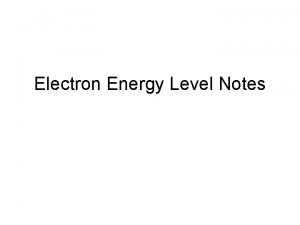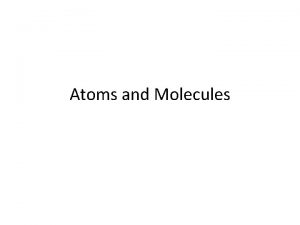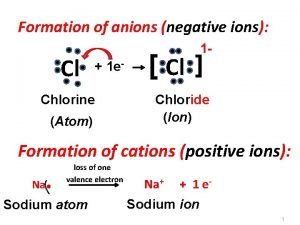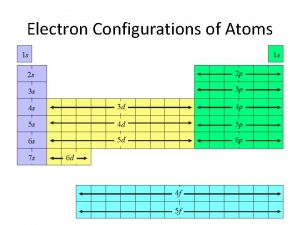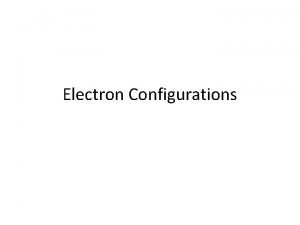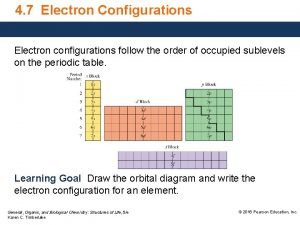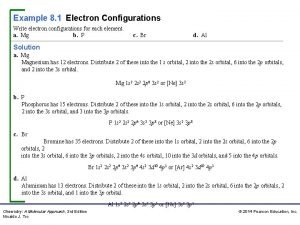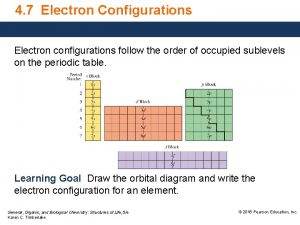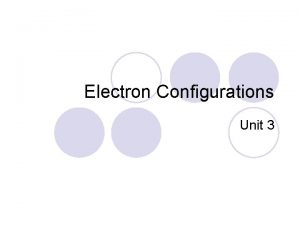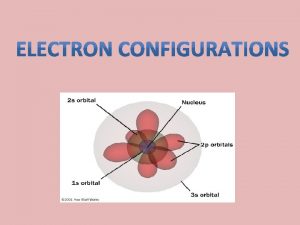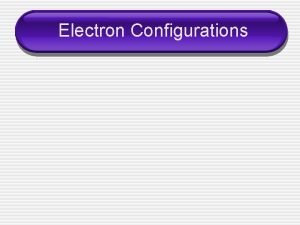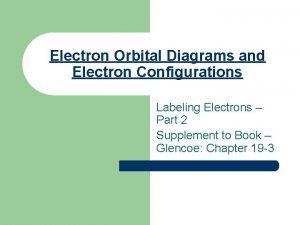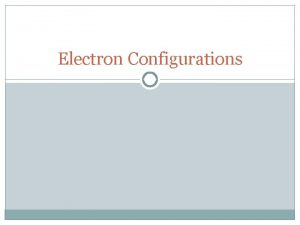ELECTRONS IN THE ATOM ELECTRON CONFIGURATIONS THE ADDRESSES









![ELECTRON APARTMENTS The apartment building has different floors [principal energy level], different apartments on ELECTRON APARTMENTS The apartment building has different floors [principal energy level], different apartments on](https://slidetodoc.com/presentation_image/14344375854d0d1c0e6504d647fb3ddc/image-10.jpg)

















- Slides: 27

ELECTRONS IN THE ATOM ELECTRON CONFIGURATIONS “THE ADDRESSES OF ELEMENTS”

EQ’s • What do the chemical properties of atoms depend on? • What is the quantum mechanical model? • How is the quantum mechanical model organized? • What is the Aufbau Principle?

ELECTRONS: The chemical properties of atoms, ions, and molecules are related to the arrangement of electrons.

EVOLUTION OF THE ATOM To understand this concept, let’s take a look at the history of the atomic models. Dalton – solid indivisible mass

EVOLUTION OF THE ATOM Thomson - The atom is a ball of positive charge with electrons stuck into the ball. Electron Positive charge

EVOLUTION OF THE ATOM Rutherford – Most of an atom’s mass is concentrated in the small, positively charged nucleus. The electrons surround the nucleus and the rest of the atom is empty space.

EVOLUTION OF THE ATOM Bohr – Electrons are arranged in concentric circular paths around the nucleus.

EVOLUTION OF THE ATOM Quantum Mechanical Model – Modern atomic theory describes the electronic structure of the atom as the probability of finding electrons within certain regions of space. 90% probability of finding the electron within this space

WHERE ARE THE ELECTRONS? The quantum mechanical model is a theoretical mathematical approach to the study of atomic and molecular structure – a very complex theory! So let’s not go there. Instead we will learn some of the basic concepts using a visual that we can all relate to: an apartment building. Vs.
![ELECTRON APARTMENTS The apartment building has different floors principal energy level different apartments on ELECTRON APARTMENTS The apartment building has different floors [principal energy level], different apartments on](https://slidetodoc.com/presentation_image/14344375854d0d1c0e6504d647fb3ddc/image-10.jpg)
ELECTRON APARTMENTS The apartment building has different floors [principal energy level], different apartments on each floor [sublevel], and rooms [orbitals] within each apartment.

PRINCIPAL ENERGY LEVELS There are seven “floors” in our building. Each of these “floors” is assigned a number. These are called the principal quantum numbers (n). Principal energy levels are assigned values in order of increasing energy: n = 1, 2, 3, 4, and so forth.

PRINCIPAL ENERGY LEVELS Take a look at your periodic table. How many periods are there?

Hummmm – do you think there may be a connection here? Seven levels, seven periods! So floor 2 (n = 2) would be the second period; Floor 5 (n = 5) would be the 5 th period

SUBLEVELS The “apartments” (sometimes called blocks or shells) within our Principal Energy Levels are identified with a letter: s, p, d or f.

Principal energy level n = 1 is a bit strange, because the sublevel s is split into two areas. If you are looking for apartment 6 s, it would be found here Apartment 4 p, would be found

ORBITALS Each sublevel (apartment) contains a very specific number of rooms (orbitals): s – blocks contain 1 orbital p – blocks contain 3 orbitals d – blocks contain 5 orbitals f – blocks contain 7 orbitals Each orbital can contain a maximum of 2 electrons.

Orbitals are difficult to show until we learn a couple of principles and one rule. A good way to remember the number of orbitals is to count (horizontally) the number of elements in a block and divide that by 2. s-block; 2 elements = 1 orbital p-block; 6 elements = 3 orbitals d-block; 10 elements = 5 orbitals f-block; 14 elements = 7 orbitals

ELECTRON CONFIGURATION The electron configuration actually gives us the location of any element on the periodic table. We simply have to be able to count as we fill in boxes! The way we read the configuration is to account for every electron in the atom – time to remember that as elements progress across the periodic table, the number of protons and electrons increase by one. A little practice is all it takes.

Hydrogen: s 1 Helium: 1 s 2 Chlorine: 1 s 22 p 63 s 23 p 5 Iron: 1 s 22 p 63 s 23 p 63 d 6

PAULI EXCLUSION PRINCIPLE An atomic orbital may describe at most two electrons. To occupy the same orbital, two electrons must have opposite spins. Arrows are used to indicate the electron and its direction of spin (↑ or ↓). An orbital containing paired electrons is written as ↑ ↓

HUND’S RULE When electrons occupy orbitals of equal energy, one electron enters each orbital until all the orbitals contain one electron with parallel spins. p orbitals When the 4 th electron is needed, it will occupy the first orbital and so on - - -

AUFBAU PRINCIPLE Electrons enter orbitals of lowest energy first 7 p 6 d 5 f 7 s 6 p 5 d Increasing Energy 4 f 6 s 5 p 4 d 5 s 4 p 3 d 4 s 3 p 3 s 2 p 2 s 1 s

Hydrogen (H):

Helium (He):

Beryllium (Be):

Aluminum (Al):

Sulfur (S):
 S electrons
S electrons Electrons configurations
Electrons configurations Copper subshell configuration
Copper subshell configuration 1s 22 s22 p63 s2
1s 22 s22 p63 s2 Electronic ions
Electronic ions Calcium ion formula
Calcium ion formula Stable electron configurations
Stable electron configurations Stable electron configurations are likely to contain
Stable electron configurations are likely to contain Orbital diagram for ca
Orbital diagram for ca An orbital is a region of space in an atom where there is
An orbital is a region of space in an atom where there is Electron configuration for 5 electrons
Electron configuration for 5 electrons Paramagnetic unpaired electrons
Paramagnetic unpaired electrons How to determine valence electrons
How to determine valence electrons Aufbau principle
Aufbau principle Fe atomic number
Fe atomic number How many electrons are in neutral 41ca atom
How many electrons are in neutral 41ca atom Atomic structure worksheet
Atomic structure worksheet The lowest allowable energy state of an atom
The lowest allowable energy state of an atom The electrons in an atom's outermost orbitals are called
The electrons in an atom's outermost orbitals are called Electrons in atoms section 2 quantum theory and the atom
Electrons in atoms section 2 quantum theory and the atom Electronegativity
Electronegativity Ceedar innovation configurations
Ceedar innovation configurations Transistor amplifier configurations
Transistor amplifier configurations 1s1 electron configuration
1s1 electron configuration Uses of bjt
Uses of bjt Flexible pavement vs rigid pavement
Flexible pavement vs rigid pavement Atom proton neutron electron
Atom proton neutron electron The formation of negative ions is
The formation of negative ions is
